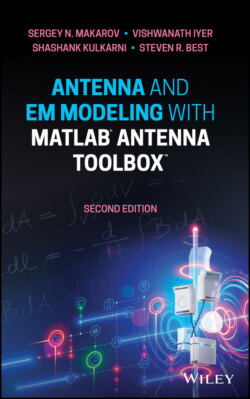Читать книгу Antenna and EM Modeling with MATLAB Antenna Toolbox - Sergey N. Makarov - Страница 22
1.4 ANTENNA INPUT IMPEDANCE AND IMPEDANCE MATCHING
ОглавлениеStrictly speaking, practical antennae can be made resonant at only one single frequency, or at a discrete number of them. Unfortunately, no antennas of finite extent exist that are matched at all frequencies.
Consider now a harmonic generator with phasor voltage Vg. In frequency domain (in terms of phasors), the generic equivalent TX circuit looks like that shown in Figure 1.3 where Za is the complex antenna impedance, which depends on the antenna frequency. Za is also called the input impedance to the antenna. The complex impedance is the most important antenna circuit characteristic, the “business card” of the antenna. The generator circuit sees only the antenna impedance; the antenna radiation is not involved. The antenna impedance becomes real at certain frequencies when antenna resonates. Indeed, the equivalent circuit in Figure 1.3 is now restricted to harmonic (sinusoidal) RF excitation and is written in terms of phasor voltages and phasor current.
Figure 1.3 A generator (its Thévenin equivalent) connected to an antenna – the equivalent circuit in frequency domain (in the phasor form) for harmonic excitation.
We now write the input antenna impedance for an arbitrary antenna both in rectangular and in the polar form:
(1.12a)
(1.12b)
respectively. The real part of the impedance, Ra, is the antenna resistance introduced in the previous text; the imaginary part, Xa, is the antenna reactance. The antenna reactance may change its behavior from inductive (Xa > 0) to capacitive (Xa < 0) and vice versa when passing through the resonance.
The angle θ in Eq. (1.12a) and (1.12b) is equivalent to the power angle of a load in power electronics. The problem of antenna impedance matching is essentially equivalent to the problem of power factor correction in power electronics, with the same implications; although different means are used in both those cases. Of primary interest to us is the average power delivered to the antenna. In terms of phasors, this power may be written using several equivalent forms:
(1.13a)
The circuit phasor current in Figure 1.3 is given by
(1.13b)
so that the average power delivered to the antenna becomes, according to Eq. (1.13a),
(1.13c)
Similar to Eq. (1.6), it can be shown that its maximum value corresponds to the ideal match, i.e. to Xa = 0, Ra = Rg, that is
(1.13d)
Thus, in order to design an efficient antenna, we must match the antenna impedance to the generator impedance, which has a typical value of 50 Ω. For every antenna type, the matching is usually achieved by changing antenna dimensions and feed geometry.
